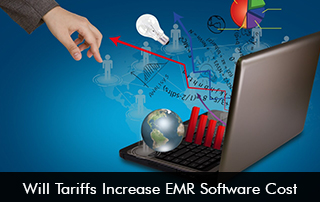The healthcare industry relies heavily on technology, and EMR software is a critical component for hospitals, clinics, and private practices. With President Trump’s proposed 2025 tariffs on imported goods, including technology and software components, many healthcare providers are concerned about potential cost increases.
In this blog, we’ll explore how these tariffs could impact EMR (Electronic Medical Records) software pricing, the broader implications for healthcare providers, and strategies to mitigate financial strain.
Understanding President Trump’s 2025 Tariff Announcements
What Are the Proposed Tariffs?
President Trump has announced a renewed push for tariffs on foreign-made goods, particularly targeting China and other major trading partners. The proposed tariffs could affect:
-
Technology hardware (servers, medical devices, and computing equipment)
-
Software components developed overseas
-
Cloud infrastructure services hosted outside the U.S.
Since EHR software often depends on global supply chains (whether for hardware, cloud hosting, or development labor) these tariffs could indirectly raise costs for healthcare providers.
How Have Tariffs Historically Impacted Tech Prices
Past tariffs under the Trump administration (2018-2020) led to increased prices for electronics and IT infrastructure. If similar policies return in 2025, healthcare organizations may face:
-
Higher costs for server equipment needed to run EMR software
-
Increased subscription fees if cloud-based EMR providers adjust pricing due to import taxes
-
Additional expenses for software updates and third-party integrations developed abroad
How Tariffs Could Directly Affect EMR Software Costs
1. Increased Hardware Expenses for On-Premise EMR Software
Many hospitals still use on-premise EMR, which requires physical servers and networking equipment. If tariffs raise the cost of these components, healthcare providers may see:
-
Higher upfront costs for server upgrades
-
Delayed IT modernization due to budget constraints
-
Increased maintenance fees if replacement parts become more expensive
2. Cloud-Based EMR Software Providers May Raise Subscription Fees
Most EHR software today is cloud-hosted (e.g., Epic, Cerner, Athenahealth). If cloud providers like AWS, Microsoft Azure, or Google Cloud face higher infrastructure costs due to tariffs, they may pass these expenses onto customers. This could result in:
-
5-15% price hikes for SaaS-based EMR solutions
-
Reduced feature updates as providers cut R&D budgets
-
Stricter contract terms to offset rising operational costs
3. Development and Support Costs Could Rise
Many EMR software companies outsource development or customer support overseas. If tariffs disrupt these labor markets, vendors might:
-
Increase licensing fees to cover higher wages for U.S.-based developers
-
Reduce offshore support teams, leading to slower response times
-
Delay new feature releases due to strained budgets
Broader Implications for Healthcare Providers and EMR Software Industry
Financial Strain on Hospitals and Clinics
Rising EMR software costs could force healthcare providers to:
-
Cut back on other critical IT investments (e.g., cybersecurity, telehealth tools)
-
Postpone EHR upgrades, leading to compliance risks with evolving regulations
-
Increase patient fees to offset technology expenses
Potential Slowdown in EMR Software Adoption
Smaller practices already struggle with the high cost of EMR software. If tariffs drive prices up further:
-
Independent doctors may delay switching from paper records
-
Rural hospitals could face even greater financial pressure
-
Interoperability efforts may stall if fewer providers can afford modern systems
Strategies to Mitigate Rising EMR Software Costs
1. Negotiate Long-Term Contracts with EMR Software Vendors
Locking in current pricing before potential tariff-induced increases can help. Consider:
-
Multi-year agreements with fixed rates
-
Bundled services (e.g., EMR + billing software) for discounts
2. Explore Open-Source or Domestic EMR Software Alternatives
Some providers may shift to:
-
Open-source EMR solutions (e.g., OpenMRS) to avoid vendor price hikes
-
U.S.-based EMR developers are less impacted by import tariffs
3. Optimize Existing EMR Software Infrastructure
Reducing inefficiencies can lower costs:
-
Audit underutilized EMR features to eliminate unnecessary add-ons
-
Migrate to hybrid cloud models to balance cost and performance
Preparing for Potential EMR Software Price Increases
President Trump’s 2025 tariff policies could lead to higher EMR software costs, affecting hospitals, clinics, and private practices. While the full impact remains uncertain, proactive measures, such as renegotiating contracts, exploring cost-effective alternatives, and optimizing current systems, can help healthcare providers manage expenses.
Staying informed about tariff developments and working closely with EMR software vendors will be crucial in navigating potential price hikes while maintaining high-quality patient care.
By focusing on these strategies, healthcare organizations can mitigate risks and ensure that EMR remains an asset rather than a financial burden in the evolving economic landscape.








